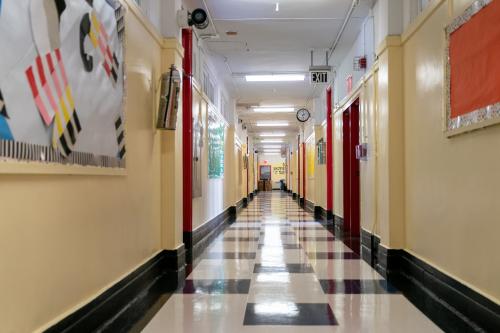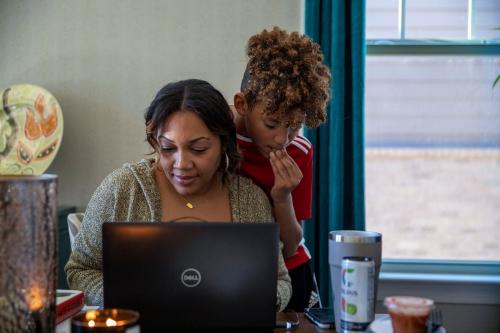We are seeing a worrisome rise in mental distress among young people in the U.S., a trend that began in 2011. Various studies show that young people are now the country’s most unhappy demographic, with unprecedented increases in anxiety, depression, and suicide. In a recent ranking of happiness in countries around the world, American young people came in at 62, behind Bulgaria, Ecuador, and Honduras.
What explains this rise? The usual sources of blame are all too familiar: smart phones, pandemic precautions, and declining church attendance, among others. In addition, political polarization, toxic debates, and misinformation increasingly influence our civic discourse and discourage the young from participating in civic life. There is also a stigma against admitting emotional problems—particularly for males—and a shortage of affordable mental-health treatments when people do.
Yet the root causes for this crisis run deeper. They include rising education costs, uncertain employment prospects and declining wages, particularly for those without a college degree, and the absence of a sense of community in many places. In a recent Brookings paper economists Anne Case and Angus Deaton found that the life expectancy for the college educated in 2021 was eight-and-a-half years longer than for the two-thirds of American adults without a bachelor’s degree—more than triple the gap in 1992. Most of the jobs available to those without a B.A. do not offer health insurance, part of the explanation for the mortality gap. These trends result in losses in human welfare and productive potential. They also exacerbate the uncertainty many young people feel about their futures.
While there is no magic bullet for this crisis, most suggested policies focus on better regulation of social media, programs that support civic engagement among youth, and better mental health care access. But an important and underreported part of the solution is restoring hope. The crisis stems in significant part from a lack of hope that often is fueled by a sense that higher education—and the economic and life expectancy benefits it brings—is beyond reach of many. My research finds strong linkages between hope and better long-term outcomes in education, health, and mental well-being, with hope more important to better outcomes of those with limited access to post-high school education and mentorship.
My recent research on populations and places vulnerable to misinformation, for example, finds that they share two linked challenges: the lack of opportunities for higher or vocational education and community-wide despair (and related deaths), with young people lacking a pathway to a better future particularly vulnerable. Solutions on the education front not only require reducing costs and increasing access to post-high school education opportunities but mentorship that supports young adults seeking more education to achieve their aspirations and suggest pathways to the kinds of employment opportunities that can give them better future lives.
Jose Santana’s story is telling. In early 2022 he was thinking about dropping out of his Bronx high school. He simply did not see a purpose in going to college. That changed the summer after he participated in Youthful Savings, a New York and Santa Monica-based program that educates low-income students in middle and high schools about economics and entrepreneurship, mental well-being, and ethical business. After completing the program, he started his own business, helping young entrepreneurs better organize and utilize web and graphic design tools. Jose earned his high school diploma this June and plans to major in business at Andrews University in Michigan.
While Jose believes the skills that he learned were valuable, what most influenced him was the mentorship he received from the program’s founder, Somya Munjal, who is a champion of educating youth about financial literacy. She shared with Jose her own struggles to pay for college and business school and how that led to what she does to support low-income youth get ahead.
On the surface, Youthful Savings may not look like a way of alleviating the mental health crisis that is plaguing American youth. Yet the program is part of a proliferating trend that has the potential to bolster young people’s mental well-being while fostering their immediate goals of acquiring more education. Somya’s ability to expand Youthful Savings was supported by Civic Wellbeing Partners, an initiative which facilitates opportunities for the young and supports well-being in low-income populations.
Somya grew up in Chicago, the child of Indian immigrants. From the time Somya was in high school, influenced by her parents’ struggles, she worked 40 hours every week. Given her strong performance in school, her parents dreamed of her attending Harvard but lost their savings during the 2001 recession. She attended Northern Illinois University, majoring in accounting. She was frustrated with her studies until she found her passion in a class about the role of education as a change agent. In Jose’s words: “Hearing Somya’s story … inspired me to continue and stay in higher education.”
Macomb Community College (MCC) outside Detroit provides another example of how to support young people in school and train them for meaningful work. The college pairs every incoming student with a mentor, which ensures that even those who need help or counseling but are reluctant to ask for it get ready assistance. Its university hub—founded in 1991—hosts several Michigan universities offering courses on its campus, providing students a more affordable route for gaining credits towards their degrees. Roughly 65% of transfer students from Macomb, many of whom remain on the home campus to get their degrees from the partner schools, complete a bachelor’s degree.
The hub—the first of its kind—has since been replicated by several other community colleges around the country, such as Lorain (Ohio) and Temple College (Austin). While some modalities have changed due to the increase of online learning, an important focus continues to be streamlining the pathway from associate to bachelor-degree completion to eliminate waste of time and money.
Restoring hope and improving mental health is not just a pipe dream.
Macomb County, traditionally a political hotbed, has a population that is divided by three very different populations: retired autoworkers, a historically discriminated African American Community, and an influx of new immigrants. The Legacy Project at MCC invests in the civic engagement of these communities as a source of learning, credible information, and reasoned discussion. Jim Jacobs, president emeritus and legacy founder, noted that “the real value added of community colleges is how well they can convince young people that their aspirations for a better a life can be obtained within their communities. It is not only more education—but the belief they can use their skills.”
Communities—and their colleges—are an important source of support for low-income populations and their youth, providing mentorship and employment opportunities, among other things. They also play an important role in stemming the tide of loneliness that is linked to mental illness, as the data from the U.K.’s Campaign to End Loneliness shows.
Dunya Kilano, the daughter of immigrants from Iraq, came to Macomb as a child and later attended the college: “College wasn’t something that felt like a clear pathway for me. I was the first in my family to go. My parents supported me although … they would have been OK if I decided to take over their business instead.” Transferring to Oakland University while still taking courses at Macomb made a four-year degree more affordable. Her college experience laid the groundwork for her career with Face Addiction Now (FAN), a community organization that provides resources, education programs, and hope to those recovering from substance use disorder. “Education …[was] helpful but the connections I made are what led me to the work I do … An advisor suggested I take a social work class; I ended up becoming president of the Social Work Club and received a leadership award. Social work was my calling.”
Another example, focused on middle and high school youth, is the BeeWell initiative in schools and communities in the U.K.’s greater Manchester District. BeeWell introduces skills such as self-esteem, adaptability, and strategies to combat loneliness into school curriculums. It has yielded significant positive effects on both the mental well-being and academic performance of the students.
The combined emphasis on individuals and communities is key to the success of these initiatives. Macomb’s focus on civic engagement helps break down barriers separating the county’s diverse populations and enhances the chance that newly educated youth will live and work there. And communities are becoming a critical part of efforts to address the mental health crisis, as the traditional individual doctor-patient model is unable to keep up with the increasing demand for services.
Reversing the decline in youth mental health and addressing the uncertainties they face are daunting challenges. While we cannot immediately resolve them, providing youth with the skills they need to navigate them is an important step forward. By helping young people gain agency, skills, and connections through education—critical links to better outcomes—these efforts show that restoring hope and improving mental health is not just a pipe dream.
-
Acknowledgements and disclosures
The author thanks Amy Goldstein and Margy Slattery for helpful comments and Isabel Shaheen O’Malley for research assistance and edits. “
The Brookings Institution is financed through the support of a diverse array of foundations, corporations, governments, individuals, as well as an endowment. A list of donors can be found in our annual reports published online here. The findings, interpretations, and conclusions in this report are solely those of its author(s) and are not influenced by any donation.






Commentary
The kids are not OK—What can we do about it?
August 15, 2024